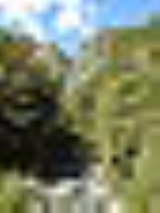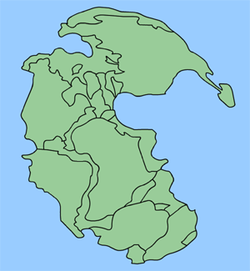
Superocean
Encyclopedia

Ocean
An ocean is a major body of saline water, and a principal component of the hydrosphere. Approximately 71% of the Earth's surface is covered by ocean, a continuous body of water that is customarily divided into several principal oceans and smaller seas.More than half of this area is over 3,000...
which surrounds a supercontinent
Supercontinent
In geology, a supercontinent is a landmass comprising more than one continental core, or craton. The assembly of cratons and accreted terranes that form Eurasia qualifies as a supercontinent today.-History:...
. It is less commonly defined as any ocean larger than the current Pacific Ocean
Pacific Ocean
The Pacific Ocean is the largest of the Earth's oceanic divisions. It extends from the Arctic in the north to the Southern Ocean in the south, bounded by Asia and Australia in the west, and the Americas in the east.At 165.2 million square kilometres in area, this largest division of the World...
. Named global superoceans include Mirovia
Mirovia
Mirovia was a hypothesized superocean which may have been a global ocean surrounding the supercontinent Rodinia in the Neoproterozoic Era, about 1 billion to 750 million years ago. The Mirovia may be essentially identical to, or the precursor of, the hypothesized Pan-African Ocean, which followed...
, which surrounded the supercontinent Rodinia
Rodinia
In geology, Rodinia is the name of a supercontinent, a continent which contained most or all of Earth's landmass. According to plate tectonic reconstructions, Rodinia existed between 1.1 billion and 750 million years ago, in the Neoproterozoic era...
, and Panthalassa
Panthalassa
Panthalassa , also known as the Panthalassic Ocean, was the vast global ocean that surrounded the supercontinent Pangaea, during the late Paleozoic and the early Mesozoic years. It included the Pacific Ocean to the west and north and the Tethys Ocean to the southeast...
, which surrounded the supercontinent Pangaea
Pangaea
Pangaea, Pangæa, or Pangea is hypothesized as a supercontinent that existed during the Paleozoic and Mesozoic eras about 250 million years ago, before the component continents were separated into their current configuration....
. Pannotia
Pannotia
Pannotia, first described by Ian W. D. Dalziel in 1997, is a hypothetical supercontinent that existed from the Pan-African orogeny about six hundred million years ago to the end of the Precambrian about five hundred and fifty million years ago. It is also known as the Vendian supercontinent...
and Columbia
Columbia (supercontinent)
Columbia, also known as Nuna and Hudsonland, was one of Earth's oldest supercontinents. It was first proposed by J.J.W. Rogers and M. Santosh and is thought to have existed approximately 1.8 to 1.5 billion years ago in the Paleoproterozoic Era. Zhao et al...
, along with landmasses before Columbia (such as Ur
Ur (continent)
Ur was a supercontinent that formed in the early Archean eon; the oldest continent on Earth, half a billion years older than Arctica. Ur joined with the continents Nena and Atlantica about to form the supercontinent Rodinia...
), were also surrounded by superoceans.
As surface water moves unobstructed east to west in superoceans, it tends to warm from the exposure to sunlight
Sunlight
Sunlight, in the broad sense, is the total frequency spectrum of electromagnetic radiation given off by the Sun. On Earth, sunlight is filtered through the Earth's atmosphere, and solar radiation is obvious as daylight when the Sun is above the horizon.When the direct solar radiation is not blocked...
so that the western edge of the ocean is warmer than the eastern. Additionally, seasonal changes in temperature, which would have been significantly more rapid inland, probably caused powerful monsoon
Monsoon
Monsoon is traditionally defined as a seasonal reversing wind accompanied by corresponding changes in precipitation, but is now used to describe seasonal changes in atmospheric circulation and precipitation associated with the asymmetric heating of land and sea...
s. In general, however, the mechanics of superoceans are not well understood.
List of superoceans
- MiroviaMiroviaMirovia was a hypothesized superocean which may have been a global ocean surrounding the supercontinent Rodinia in the Neoproterozoic Era, about 1 billion to 750 million years ago. The Mirovia may be essentially identical to, or the precursor of, the hypothesized Pan-African Ocean, which followed...
(RodiniaRodiniaIn geology, Rodinia is the name of a supercontinent, a continent which contained most or all of Earth's landmass. According to plate tectonic reconstructions, Rodinia existed between 1.1 billion and 750 million years ago, in the Neoproterozoic era...
) - Pan-African OceanPan-African OceanThe Pan-African Ocean is a hypothesized paleo-ocean whose closure created the supercontinent of Pannotia. The ocean may have existed before the break-up of the supercontinent of Rodinia. The ocean closed before the beginning of the Phanerozoic Eon, when the Panthalassa ocean expanded, and was...
(PannotiaPannotiaPannotia, first described by Ian W. D. Dalziel in 1997, is a hypothetical supercontinent that existed from the Pan-African orogeny about six hundred million years ago to the end of the Precambrian about five hundred and fifty million years ago. It is also known as the Vendian supercontinent...
) - PanthalassaPanthalassaPanthalassa , also known as the Panthalassic Ocean, was the vast global ocean that surrounded the supercontinent Pangaea, during the late Paleozoic and the early Mesozoic years. It included the Pacific Ocean to the west and north and the Tethys Ocean to the southeast...
(PangaeaPangaeaPangaea, Pangæa, or Pangea is hypothesized as a supercontinent that existed during the Paleozoic and Mesozoic eras about 250 million years ago, before the component continents were separated into their current configuration....
) - Mega Pacific Ocean (Pangaea UltimaPangaea UltimaPangaea Ultima is a possible future supercontinent configuration and an alternative to the Amasia supercontinent. Consistent with the supercontinent cycle, Pangaea Ultima could occur within the next 250 million years...
) - Super Atlantic Ocean (AmasiaAmasia (continent)Amasia is a possible future supercontinent that could be formed by the merger of Asia and North America and is an alternative to Pangaea Ultima. This relies mostly on the fact that the Pacific Plate is already subducting under Eurasia and North America, a process which if continued will eventually...
) - Super Indian Ocean (AmasiaAmasia (continent)Amasia is a possible future supercontinent that could be formed by the merger of Asia and North America and is an alternative to Pangaea Ultima. This relies mostly on the fact that the Pacific Plate is already subducting under Eurasia and North America, a process which if continued will eventually...
)

